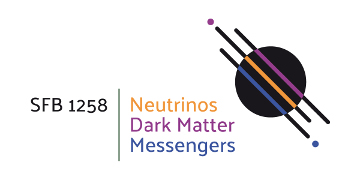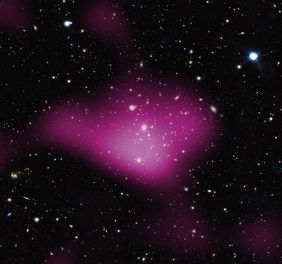Since the 1930s various astronomical observations lead to the conclusion that the Universe consists not only of the matter we can see with telescopes, but also of invisible matter. This invisible or dark matter constitutes a portion of about 25% of the Universe's mass. Theoretical particle physics suggest that this dark matter (DM) might be of particle nature – DM particles that interact with the visible matter only through the gravitational and weak force. The former is the same force that lets apples drop from trees, while the latter powers radioactivity. For these hypothesized very light and very small elementary particles, the strength of both forces is supposed to be extremely small. Hence, interactions with the visible matters are possible, but very rare.
DM interaction rate depends on particle velocities
In the recent past physicists around the world have built detector experiments to observe those DM particles either directly via their interaction with the visible matter, or indirectly via the detection of the visible particles produced by the interaction of the DM particles with themselves.
The rate of particle interactions in the detectors depends on the flux of DM particles in our solar system and hence on the amount of particles and their velocities. The former is well inferred from astronomical observations, while the latter is unknown.
Usually, a Maxwell-Boltzmann distribution is assumed
A common approach is to assume a Maxwell-Boltzmann velocity distribution - the same that can describe the velocities of molecules in air. However, for DM particles this assumption might hold only for very large distance scales, larger than our solar system. Within our solar system the particle velocities might deviate from the Maxwell-Boltzmann distribution rather strongly, which has a large effect on the interpretation of the results from DM detector experiments. Therefore, it is important to be able to derive the results in a way independent of the velocity distribution.
Alejandro Ibarra and Andreas Rappelt, scientists from the Collaborative Research Center 1258 (SFB1258) at the Technical University of Munich have developed a new method to calculate the expected number of particle interactions in a DM detector without making any assumptions on the DM velocity distribution, and by taking into account constraints from other detector experiments.
Combining experiments velocity-distribution independent
Their new method exploits the fact that the rate of DM particle interaction is linear in the velocity distribution. Hence, a velocity distribution can be determined that minimizes or maximizes the outcome of an experiment subject to the constraints from other experiments. Thus, the results of the different experiments can be combined in a velocity-distribution-independent way.
The DAMA signal infers a DM mass above 4.5 TeV
Ibarra and Rappelt applied their method to investigate the compatibility of the DM annual modulation signal claimed by the DAMA experiment with the null results from other direct and indirect DM detection experiments (PandaX, Pico60, IceCube and Super-Kamiokande). They find that the DAMA signal can only be made compatible with the null results by having a very fine-tuned low velocity dispersed DM velocity distribution and a fairly large DM mass of greater than 4.5 TeV, which is considered very unlikely.
Furthermore, the authors have derived velocity distribution-independent limits on the DM-nucleon scattering cross-section, i.e. how likely DM particles interact with ordinary visible matter, by combining the null results from various DM detection experiments (PandaX, Pico60, IceCube, and Super-Kamiokande). "The limits we obtain are remarkably strong", Ibarra and Rappelt say.
With respect to the future DM detection experiment LUX-ZEPLIN (LZ) and in view of the present null results from IceCube, Super-Kamiokande, SuperCDMS and Pico60 the authors utilized the new method to assess the prospects to observe a DM signal with this future experiment. Depending on the actual DM-nucleon scattering cross-section and DM mass, a signal will be detectable for none, a subset, or all possible DM velocity distributions.
Original publication
Alejandro Ibarra and Andreas Rappelt: "<link https: arxiv.org abs external-link-new-window internen link im aktuellen>Optimized velocity distribution for direct dark matter detection", Journal of Cosmology and Astroparticle Physics, Volume 2017, August 2017
DOI: <link http: iopscience.iop.org article pdf external-link-new-window internen link im aktuellen>10.1088/1475-7516/2017/08/039



